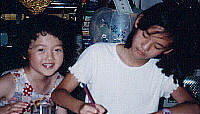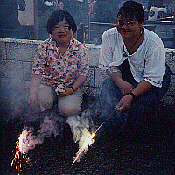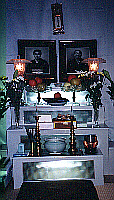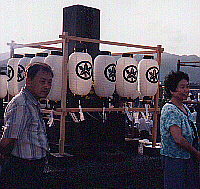 The first Festival of the Dead
after a family member passes away is called hatsubon*. A few special touches are added
to the regular obon protocol.
The first Festival of the Dead
after a family member passes away is called hatsubon*. A few special touches are added
to the regular obon protocol.
* Other names are shin-bon and nii-bon
Obaa-san died just two months after Ojii-san earlier this year, so a
shouryoudana (spirit altar)
was set up to honour them both in the kyakuma (visitor receiving room) of their house in Fukue.
We lit sticks of incense and placed them in the sand bowl lying down, not upright.
There is an eggplant in the offering dish. Can you guess
the reason why?
On the first day of obon, a bo-san (Buddhist priest) came to the house in the morning
to chant a 30 minute-long sutra for the spirits of Ojii-san and Obaa-san.
He was the 30-ish son of the bo-san who did Ojii-san's
shijuku-nichi ceremony in April.
We complimented him on his fine voice. He thanked us, but he said he wasn't sure whether
it would hold up over the course of this busy day, as he climbed onto
his moped (scooter) to race to his next appointment!
|
Buddhist priesthood is usually passed down in families in Japan.
|
 Throughout the day during obon, relatives and friends of the family would drop by the house
to pay their respects. Cousin Yoko and her family arrived on the ferry from Nagasaki on
the second day. They were visiting from Ireland, where Yoko Neh-san's husband has been
assigned to the "Celtic Tiger"'s NEC
semiconductor operation for the past few years.
Their two young daughters attend a Japanese school run by the Japanese companies for
the children of sojourning employees. They will be returning to Japan later this year.
At only 11 and 6 years of age, they will probably be spared the problems that older kikoku shijo
(returnee children) have fitting back into Japanese society.
Throughout the day during obon, relatives and friends of the family would drop by the house
to pay their respects. Cousin Yoko and her family arrived on the ferry from Nagasaki on
the second day. They were visiting from Ireland, where Yoko Neh-san's husband has been
assigned to the "Celtic Tiger"'s NEC
semiconductor operation for the past few years.
Their two young daughters attend a Japanese school run by the Japanese companies for
the children of sojourning employees. They will be returning to Japan later this year.
At only 11 and 6 years of age, they will probably be spared the problems that older kikoku shijo
(returnee children) have fitting back into Japanese society.
|
Shijo Tsushin
A bilingual E-zine for kikoku shijo by kikoku shijo
|
Part of the day was spent at the cemetery doing ohaka (tomb) maintenance: sweeping up the dirt and dust,
adding fresh water to the bowl in front, and decorating with bouquets of flowers, one on either side.
Most Japanese today live too far away from their ohaka to be regularly placing
fresh flowers, so artificial ones are increasingly being used. I also saw a television profile of a
company that for a fee will do the maintenance, take a dated photo or video of the cleaned ohaka
and do some praying to boot! After all that work in the hot sun, it was nice to cool off with
some kakigouri (shaved ice).

 During the hot summer months in Japan the most welcome store sign to see is this one: "ice",
meaning "kakigouri (shaved ice) served here". Sno-cone, Slurpee -- everywhere has a version
of shaved ice it seems. In Japan it comes in green tea flavour with a dollop of azuki
(sweet red beans). Fruit flavours like strawberry and melon are also popular. Thanks to Japanese immigrants, there is
kakigouri in Hawai'i.
During the hot summer months in Japan the most welcome store sign to see is this one: "ice",
meaning "kakigouri (shaved ice) served here". Sno-cone, Slurpee -- everywhere has a version
of shaved ice it seems. In Japan it comes in green tea flavour with a dollop of azuki
(sweet red beans). Fruit flavours like strawberry and melon are also popular. Thanks to Japanese immigrants, there is
kakigouri in Hawai'i.
History of kakigouri in Japan
Make kakigouri at Home
|
Just before sunset every evening it was time to hang the chochin (lanterns) around the ohaka.
For hatsubon a new frame and new lanterns with white fusa (tassels) had been
purchased. These will be used for obon in future years.
We attached temporary paper nametags to the frame to acknowledge those
who had made financial contributions. Looking around the cemetery, one family had a death just before
obon and was going through the
Japanese funeral rite. I felt sorry for them, not only for their loss,
but also because they had to wear formal black suits and dresses in the 30-degree heat!
 Especially for hatsubon, we hung an extra big lantern in front of
Ojii-san and Obaa-san's house.
Like the ohaka lanterns, this one had the Hiruki
kamon (family crest),
omodaka,
a design of a water plantain flower.
The crest is meant to help the spirits of the dead find their way to their former home
in the world of the living.
Especially for hatsubon, we hung an extra big lantern in front of
Ojii-san and Obaa-san's house.
Like the ohaka lanterns, this one had the Hiruki
kamon (family crest),
omodaka,
a design of a water plantain flower.
The crest is meant to help the spirits of the dead find their way to their former home
in the world of the living.

Cousin Emi (L) and
my sister (R)
enjoy some hanabi.
|
Of course we lit some hanabi (fireworks). Cousin Emi (left)
lit the wrong end of her senko hanabi (sparking firework) and wondered why nothing happened.
The business end has a sulphur-rich blackpowder, which when lit forms a
molten composition that reacts with the air to produce attractive tiny branching sparks.
I showed Emi-chan how to use a senko hanabi: hold the safe end and be *very*
still while you appreciate the delicate beauty coming from the glowing drop at the other end;
one false move and the drop falls from the stem, ending your pleasurable experience (until you light the next one!).
|
 The first Festival of the Dead
after a family member passes away is called hatsubon*. A few special touches are added
to the regular obon protocol.
The first Festival of the Dead
after a family member passes away is called hatsubon*. A few special touches are added
to the regular obon protocol.

 Throughout the day during obon, relatives and friends of the family would drop by the house
to pay their respects. Cousin Yoko and her family arrived on the ferry from Nagasaki on
the second day. They were visiting from Ireland, where Yoko Neh-san's husband has been
assigned to the "Celtic Tiger"'s
Throughout the day during obon, relatives and friends of the family would drop by the house
to pay their respects. Cousin Yoko and her family arrived on the ferry from Nagasaki on
the second day. They were visiting from Ireland, where Yoko Neh-san's husband has been
assigned to the "Celtic Tiger"'s 
 During the hot summer months in Japan the most welcome store sign to see is this one: "ice",
meaning "kakigouri (shaved ice) served here". Sno-cone, Slurpee -- everywhere has a version
of shaved ice it seems. In Japan it comes in green tea flavour with a dollop of azuki
(sweet red beans). Fruit flavours like strawberry and melon are also popular. Thanks to Japanese immigrants, there is
During the hot summer months in Japan the most welcome store sign to see is this one: "ice",
meaning "kakigouri (shaved ice) served here". Sno-cone, Slurpee -- everywhere has a version
of shaved ice it seems. In Japan it comes in green tea flavour with a dollop of azuki
(sweet red beans). Fruit flavours like strawberry and melon are also popular. Thanks to Japanese immigrants, there is

 Especially for hatsubon, we hung an extra big lantern in front of
Ojii-san and Obaa-san's house.
Like the ohaka lanterns, this one had the Hiruki
kamon (family crest),
Especially for hatsubon, we hung an extra big lantern in front of
Ojii-san and Obaa-san's house.
Like the ohaka lanterns, this one had the Hiruki
kamon (family crest),

